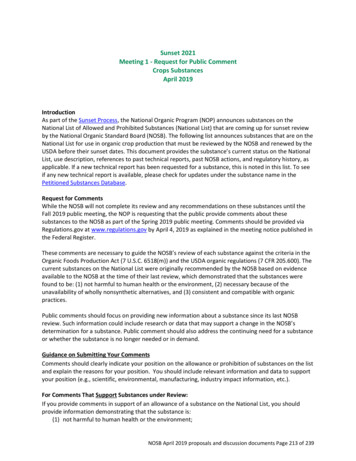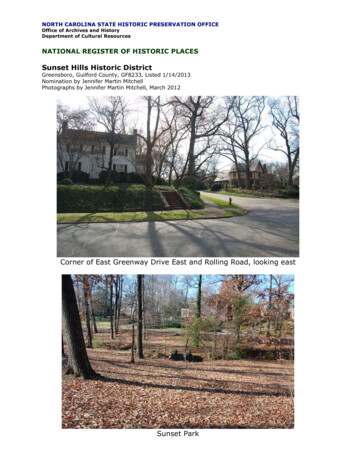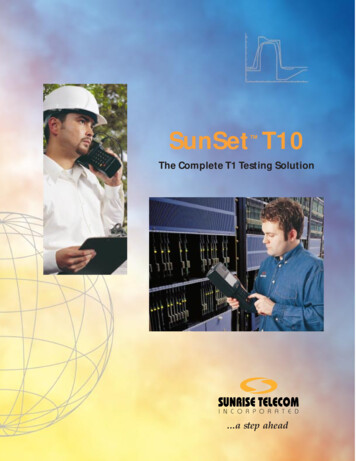
Transcription
Sunset 2021Meeting 1 - Request for Public CommentCrops SubstancesApril 2019IntroductionAs part of the Sunset Process, the National Organic Program (NOP) announces substances on theNational List of Allowed and Prohibited Substances (National List) that are coming up for sunset reviewby the National Organic Standard Board (NOSB). The following list announces substances that are on theNational List for use in organic crop production that must be reviewed by the NOSB and renewed by theUSDA before their sunset dates. This document provides the substance’s current status on the NationalList, use description, references to past technical reports, past NOSB actions, and regulatory history, asapplicable. If a new technical report has been requested for a substance, this is noted in this list. To seeif any new technical report is available, please check for updates under the substance name in thePetitioned Substances Database.Request for CommentsWhile the NOSB will not complete its review and any recommendations on these substances until theFall 2019 public meeting, the NOP is requesting that the public provide comments about thesesubstances to the NOSB as part of the Spring 2019 public meeting. Comments should be provided viaRegulations.gov at www.regulations.gov by April 4, 2019 as explained in the meeting notice published inthe Federal Register.These comments are necessary to guide the NOSB’s review of each substance against the criteria in theOrganic Foods Production Act (7 U.S.C. 6518(m)) and the USDA organic regulations (7 CFR 205.600). Thecurrent substances on the National List were originally recommended by the NOSB based on evidenceavailable to the NOSB at the time of their last review, which demonstrated that the substances werefound to be: (1) not harmful to human health or the environment, (2) necessary because of theunavailability of wholly nonsynthetic alternatives, and (3) consistent and compatible with organicpractices.Public comments should focus on providing new information about a substance since its last NOSBreview. Such information could include research or data that may support a change in the NOSB’sdetermination for a substance. Public comment should also address the continuing need for a substanceor whether the substance is no longer needed or in demand.Guidance on Submitting Your CommentsComments should clearly indicate your position on the allowance or prohibition of substances on the listand explain the reasons for your position. You should include relevant information and data to supportyour position (e.g., scientific, environmental, manufacturing, industry impact information, etc.).For Comments That Support Substances under Review:If you provide comments in support of an allowance of a substance on the National List, you shouldprovide information demonstrating that the substance is:(1) not harmful to human health or the environment;NOSB April 2019 proposals and discussion documents Page 213 of 239
(2) necessary to the production of the agricultural products because of the unavailability of whollynonsynthetic substitute products; and(3) consistent with organic crop production.For Comments That Do Not Support Substances Under Review:If you provide comments that do not support a substance on the National List, you should providereasons why the use of the substance should no longer be allowed in organic production or handling.Specifically, comments that support the removal of a substance from the National List should providenew information since its last NOSB review to demonstrate that the substance is:(1) harmful to human health or the environment;(2) unnecessary because of the availability of alternatives; and(3) inconsistent with crop production.For Comments Addressing the Availability of Alternatives:Comments may present information about the viability of alternatives for a substance under sunsetreview. Viable alternatives include, but are not limited to: Alternative management practices that would eliminate the need for the specific substance; Other currently exempted substances that are on the National List, which could eliminate theneed for this specific substance; and Other organic or nonorganic agricultural substances.Your comments should address whether any alternatives have a function and effect equivalent to orbetter than the allowed substance, and whether you want the substance to be allowed or removed fromthe National List. Assertions about alternative substances, except for those alternatives that alreadyappear on the National List, should, if possible, include the name and address of the manufacturer of thealternative. Further, your comments should include a copy or the specific source of any supportiveliterature, which could include product or practice descriptions; performance and test data; referencestandards; names and addresses of producers or handlers who have used the alternative under similarconditions and the date of use; and an itemized comparison of the function and effect of the proposedalternative(s) with substance under review.Written public comments will be accepted through April 4, 2019 via www.regulations.gov. Commentsreceived after that date may not be reviewed by the NOSB before the meeting.NOSB April 2019 proposals and discussion documents Page 214 of 239
Sunset 2021Meeting 1 - Request for Public CommentCrops SubstancesApril 2019Note: With the exception of Ferric Phosphate and Hydrogen Chloride the materials included in this listare undergoing early sunset review as part of November 18, 2016, NOSB recommendation on efficientworkload re-organization.Reference: 205.601 Synthetic substances allowed for use in organic crop production.Hydrogen peroxide (a)Hydrogen peroxide (i)Soaps, ammoniumOils, horticultural (e)Oils, horticultural (i)PheromonesFerric phosphatePotassium bicarbonateMagnesium sulfateHydrogen chlorideReference: 205.602 Nonsynthetic substances prohibited for use in organic crop production.Ash from manure burningSodium fluoaluminateLinks to additional references and supporting materials for each substance can be found on the NOPwebsite: national-list/petitionedNOSB April 2019 proposals and discussion documents Page 215 of 239
Hydrogen peroxide—§205.601(a)§205.601 Synthetic substances allowed for use in organic crop production.Reference: 205.601(a) As algicide, disinfectants, and sanitizer, including irrigation system cleaningsystems. (4) Hydrogen peroxide.Technical Report(s): 1995 TAP; 2015 TRPetition(s): N/APast NOSB Actions: 10/1995 NOSB minutes and vote; 11/2005 sunset recommendation -deferred;06/2006 sunset recommendation; 10/2010 sunset recommendation10/2015 sunset recommendationRecent Regulatory Background: Sunset renewal notice published 06/06/12 (77 FR 33290); Renewed03/15/2017 (82 FR 14420)Sunset Date: 3/15/2022Background from Subcommittee:UseHydrogen peroxide is widely used as a disinfectant and bleaching agent. It is an effective and anenvironmentally benign substance used to reduce and control microorganisms for food safety purposes.It is critical for sanitizing aseptic packaging. It is a weak acid but a strong oxidizer, and this makes it veryuseful as a fungicide, cleaning agent, and for disease control.ManufactureHydrogen peroxide is a very simple molecule with a formula of H2O2. Virtually all modern productionfacilities manufacture commercial hydrogen peroxide solutions using large, strategically locatedanthraquinone autoxidation processes. Improved production methods and facilities based on theanthraquinone (AO) process have recently appeared in the commercial patent literature.Hydrogen peroxide is a naturally occurring inorganic compound; however, the sources of hydrogenperoxide used in commercial fungicides, disinfectants and antiseptic products are produced throughchemical synthesis. Industrial methods for the preparation of hydrogen peroxide are categorized asoxidation-reduction reactions. Modern commercial methods for hydrogen peroxide synthesis involvethe transition-metal catalyzed chemical reduction of an alkyl anthraquinone with hydrogen (H2) gas tothe corresponding hydroquinone followed by regenerative oxidation of the latter species in air.International AcceptanceThe 2015 TR notes that a subset of the international organizations surveyed have provided guidance onthe application of hydrogen peroxide for disinfection and plant disease control in organic cropproduction.Canadian General Standards Board: allows numerous uses of hydrogen peroxide in organic production.Under Section 4.3: “Crop production aids and materials,” hydrogen peroxide is not allowed in maplesyrup production but is allowed for use as a fungicide. Section 5.3: “Health care and production aids forlivestock production” lists pharmaceutical grade hydrogen peroxide for external use as a disinfectant,and food-grade hydrogen peroxide for internal use (e.g., livestock drinking water). Hydrogen peroxide isalso listed in Section 7.3: “Food-grade cleaners, disinfectants and sanitizers” that are allowed withoutmandatory removal of residues, and 7.4: “Cleaners, disinfectants and sanitizers allowed on food contactsurfaces including equipment, provided that substances are removed from food contact surfaces priorto organic production” (CAN, 2011).NOSB April 2019 proposals and discussion documents Page 216 of 239
European Union: According to Annex VII of EU regulation 889/2008, hydrogen peroxide is allowed forcleaning and disinfection of buildings and installations for animal production. Specifically, hydrogenperoxide can be used to satisfy Article 23 (4), which states that “housing, pens, equipment and utensilsshall be properly disinfected to prevent cross-contamination and the buildup of disease carryingorganisms.” Hydrogen peroxide is also permitted for use in the production of gelatin under Section B ofAnnex VIII: and substances for use in production of processed organic food (EC, 2008).International Federation of Organic Agriculture Movements: Hydrogen peroxide is permitted underAppendix 4 – Table 2 of the IFOAM Norms as an equipment cleanser and disinfectant. In addition,Appendix 5 lists hydrogen peroxide as an approved substance for pest and disease control anddisinfection in livestock housing and equipment (IFOAM, 2014). The Norms make no mention ofhydrogen peroxide for plant disease control and prevention.UK Soil Association: Standards permit the use of hydrogen peroxide only as a cleaning product forlivestock housing areas. No conditions are provided allowing the use of hydrogen peroxide for plantdisease control and prevention (Soil Association, 2014).Environmental Issues (could include human health issues)Contamination is not expected when purified forms of hydrogen peroxide are released to theenvironment following normal use. At typical pesticide concentrations, hydrogen peroxide is expectedto rapidly degrade to oxygen gas and water (US EPA, 2007). Large-volume spills and other releases ofconcentrated hydrogen peroxide could present a fire hazard since the substance readily decomposes torelease oxygen gas. Pure hydrogen peroxide is not flammable and can be diluted with clean water tominimize the risk of fire. Although concentrated hydrogen peroxide is nonflammable, it is a powerfuloxidizing agent that may spontaneously combust on contact with organic material and becomesexplosive when heated. Combustion reactions and explosions resulting from accidental spills ofconcentrated hydrogen peroxide could therefore lead to environmental degradation.Discussion:A technical report (TR) was commissioned in 2015 for hydrogen peroxide since the information from theprevious 1995 TAP was old and incomplete. It showed that hydrogen peroxide is inherently unstable andbreaks down readily into oxygen and water. (TR Evaluation question 3-5). While it is toxic to diseasespores and cells on contact, it has absolutely no residual effect. It has low or no impacts on birds,humans, or fish if it is used according to the label and protective application measures are taken. Therecan be some effects on soil microbiota in the very top layer of soil where it may come in contact, butbecause it breaks down so quickly, soil life is quickly restored. (TR 2015 Evaluation Question #8).While there are some alternatives on the National List for sanitizers and disinfectants, as well as someessential oils with antiseptic properties, the National List items are not necessarily any better or saferthan hydrogen peroxide, and the essential oils have not been studied to compare with hydrogenperoxide side-by side to see if they are equally as effective and equally benign. (TR Evaluation question11). Certain bacterial and fungal products that are beneficial in controlling plant diseases may be validalternatives for some uses as a fungicide, but often these are best used as preventatives and are noteffective once a disease has taken hold, and they are not good substitutes in all situations. Likewise,some biological, cultural and physical methods keep the need for use of hydrogen peroxide to aminimum, but don't apply to every situation. (TR Evaluation question 12).In the 2015 sunset review most public commenters supported keeping hydrogen peroxide on theNational List. It was frequently mentioned that it is one of the few tools left against fire blight now thatNOSB April 2019 proposals and discussion documents Page 217 of 239
antibiotics cannot be used. It is widely used to clean equipment, in mushroom production, and toalternate with other materials for resistance management. No comments were put forward with newinformation that would contribute to the OFPA criteria review. The NOSB found the material to meetOFPA criteria and had no objection to continued listing. No significant new issues were raised by thepublic.Additional information requested by Subcommittee: NoneHydrogen peroxide—§205.601(i)§205.601 Synthetic substances allowed for use in organic crop production.Reference: 205.601(i) As plant disease control. (5) Hydrogen peroxide.Technical Report(s): 1995 TAP; 2015 TRPetition(s): N/APast NOSB Actions: 10/1995 NOSB minutes and vote; 11/2005 sunset recommendation -deferred;06/2006 sunset recommendation; 10/2010 sunset recommendation10/2015 sunset recommendationRecent Regulatory Background: Sunset renewal notice published 06/06/12 (77 FR 33290); Renewed03/15/2017 (82 FR 14420)Sunset Date: 3/15/2022Background from Subcommittee:UseHydrogen peroxide is widely used as a disinfectant and bleaching agent. It is an effective and anenvironmentally benign substance used to reduce and control microorganisms for food safety purposes.It is critical for sanitizing aseptic packaging. It is a weak acid but a strong oxidizer, and this makes it veryuseful as a fungicide, cleaning agent, and for disease control.ManufactureHydrogen peroxide is a very simple molecule with a formula of H2O2. Virtually all modern productionfacilities manufacture commercial hydrogen peroxide solutions using large, strategically locatedanthraquinone autoxidation processes. Improved production methods and facilities based on theanthraquinone (AO) process have recently appeared in the commercial patent literature.Hydrogen peroxide is a naturally occurring inorganic compound; however, the sources of hydrogenperoxide used in commercial fungicides, disinfectants and antiseptic products are produced throughchemical synthesis. Industrial methods for the preparation of hydrogen peroxide are categorized asoxidation-reduction reactions. Modern commercial methods for hydrogen peroxide synthesis involvethe transition-metal catalyzed chemical reduction of an alkyl anthraquinone with hydrogen (H2) gas tothe corresponding hydroquinone followed by regenerative oxidation of the latter species in air.International AcceptanceThe 2015 TR notes that a subset of the international organizations surveyed have provided guidance onthe application of hydrogen peroxide for disinfection and plant disease control in organic cropproduction.NOSB April 2019 proposals and discussion documents Page 218 of 239
Canadian General Standards Board: allows numerous uses of hydrogen peroxide in organic production.Under Section 4.3: “Crop production aids and materials,” hydrogen peroxide is not allowed in maplesyrup production but is allowed for use as a fungicide. Section 5.3: “Health care and production aids forlivestock production” lists pharmaceutical grade hydrogen peroxide for external use as a disinfectant,and food-grade hydrogen peroxide for internal use (e.g., livestock drinking water). Hydrogen peroxide isalso listed in Section 7.3: “Food-grade cleaners, disinfectants and sanitizers” that are allowed withoutmandatory removal of residues, and 7.4: “Cleaners, disinfectants and sanitizers allowed on food contactsurfaces including equipment, provided that substances are removed from food contact surfaces priorto organic production” (CAN, 2011).European Union: According to Annex VII of EU regulation 889/2008, hydrogen peroxide is allowed forcleaning and disinfection of buildings and installations for animal production. Specifically, hydrogenperoxide can be used to satisfy Article 23 (4), which states that “housing, pens, equipment and utensilsshall be properly disinfected to prevent cross-contamination and the buildup of disease carryingorganisms.” Hydrogen peroxide is also permitted for use in the production of gelatin under Section B ofAnnex VIII: and substances for use in production of processed organic food (EC, 2008).International Federation of Organic Agriculture Movements: Hydrogen peroxide is permitted underAppendix 4 – Table 2 of the IFOAM Norms as an equipment cleanser and disinfectant. In addition,Appendix 5 lists hydrogen peroxide as an approved substance for pest and disease control anddisinfection in livestock housing and equipment (IFOAM, 2014). The Norms make no mention ofhydrogen peroxide for plant disease control and prevention.UK Soil Association: Standards permit the use of hydrogen peroxide only as a cleaning product forlivestock housing areas. No conditions are provided allowing the use of hydrogen peroxide for plantdisease control and prevention (Soil Association, 2014).Environmental Issues (could include human health issues)Contamination is not expected when purified forms of hydrogen peroxide are released to theenvironment following normal use. At typical pesticide concentrations, hydrogen peroxide is expectedto rapidly degrade to oxygen gas and water (US EPA, 2007). Large-volume spills and other releases ofconcentrated hydrogen peroxide could present a fire hazard since the substance readily decomposes torelease oxygen gas. Pure hydrogen peroxide is not flammable and can be diluted with clean water tominimize the risk of fire. Although concentrated hydrogen peroxide is nonflammable, it is a powerfuloxidizing agent that may spontaneously combust on contact with organic material and becomesexplosive when heated. Combustion reactions and explosions resulting from accidental spills ofconcentrated hydrogen peroxide could therefore lead to environmental degradation.Discussion:A technical report (TR) was commissioned in 2015 for hydrogen peroxide since the information from theprevious 1995 TAP was old and incomplete. It showed that hydrogen peroxide is inherently unstable andbreaks down readily into oxygen and water. (TR Evaluation question 3-5). While it is toxic to diseasespores and cells on contact, it has absolutely no residual effect. It has low or no impacts on birds,humans, or fish if it is used according to the label and protective application measures are taken. Therecan be some effects on soil microbiota in the very top layer of soil where it may come in contact, butbecause it breaks down so quickly, soil life is quickly restored. (TR 2015 Evaluation Question #8).While there are some alternatives on the National List for sanitizers and disinfectants, as well as someessential oils with antiseptic properties, the National List items are not necessarily any better or saferNOSB April 2019 proposals and discussion documents Page 219 of 239
than hydrogen peroxide, and the essential oils have not been studied to compare with hydrogenperoxide side-by side to see if they are equally as effective and equally benign. (TR Evaluation question11). Certain bacterial and fungal products that are beneficial in controlling plant diseases may be validalternatives for some uses as a fungicide, but often these are best used as preventatives and are noteffective once a disease has taken hold, and they are not good substitutes in all situations. Likewise,some biological, cultural and physical methods keep the need for use of hydrogen peroxide to aminimum, but don't apply to every situation. (TR Evaluation question 12).In the 2015 sunset review most public commenters supported keeping hydrogen peroxide on theNational List. It was frequently mentioned that it is one of the few tools left against fire blight now thatantibiotics cannot be used. It is widely used to clean equipment, in mushroom production, and toalternate with other materials for resistance management. No comments were put forward with newinformation that would contribute to the OFPA criteria review. The NOSB found the material to meetOFPA criteria and had no objection to continued listing. No significant new issues were raised by thepublic.Additional information requested by Subcommittee: NoneSoaps, ammonium§205.601 Synthetic substances allowed for use in organic crop production.Reference: 205.601(d) As animal repellents—Soaps, ammonium—for use as a large animal repellantonly, no contact with soil or edible portion of crop.Technical Report: 1996 TAP; 2019 TR pending (to be posted at national-list/a)Petition(s): N/APast NOSB Actions: 10/1995 NOSB minutes and vote; 11/2005 sunset recommendation; 10/2010sunset recommendation; 10/2015 sunset recommendationRecent Regulatory Background: Sunset renewal notice published 06/06/12 (77 FR 33290); Renewed03/15/2017 (82 FR 14420)Sunset Date: 3/15/2022Background from Subcommittee:UseAmmonium soaps are used as animal repellents to protect organically produced crops from unwantedbrowsing, primarily from deer and rabbits. USDA organic regulations allow ammonium soaps as a"synthetic substance allowed for use in organic crop production" at 7 CFR 205.601.ManufactureAmmonium soaps are manufactured by hydrolysis of fats (triglycerides) with an alkaline source in asaponification process. In this process, the base reacts with the fatty ester to break the ester linkages,resulting in the formation of a salt with the cation of the base and the carboxylate anion that remains atthe end of the hydrolysis. A wide range of fats may be used in the saponification process, including bothplant and animal fats. Because of the relative abundance of fats and their low cost, most soaps areproduced by the saponification of natural fats. Ammonium cations also exist in nature and play anNOSB April 2019 proposals and discussion documents Page 220 of 239
important role in the metabolic pathways of a range of organisms , as well as being a key component ofthe nitrogen cycle. Soaps, however, do not naturally exist in nature but are manufactured.International acceptanceCanadian General Standards Board Permitted Substances List - Ammonium soaps are listed in theCAN/CGSB-32.311-2015 - Organic production systems - permitted substances lists.Environmental issues and human healthStudies conducted by the EPA estimate that ammonium soaps will undergo rapid degradation in theenvironment, primarily through microbial metabolism, yielding an environmental half-life of less thanone day. Interesting to note that the toxicological profile of the substance differs based on theenvironment in which it is located. They are regarded as having low toxicity to terrestrial organisms,with little impact to mammals and avian animals. The EPA has placed them in Toxicity Category IV, thelowest available classification. They are, however, moderately toxic in aquatic environments.Ammonium soaps have been classified as "highly toxic" to crustaceans by the EPA. Due to the potentialtoxicity to aquatic environments, ammonium soap repellent product labels stipulate "This product maybe hazardous to aquatic invertebrates. Do not apply to water bodies such as ponds or creeks.The EPA has given ammonium soaps the lowest possible toxicity classification (Toxicity Category IV).They have also concluded that the oral intake of dangerous levels of the substance is highly unlikely dueto the recognizable and undesirable soap taste. Despite the low toxicity of ammonium soaps there aresome health risks. They are primarily irritation-based. Occasional skin irritation upon prolongedexposure has been reported as potential problems with direct exposure in the eye.DiscussionThere are some alternative methods that make the use of ammonium soaps unnecessary. They includepopulation control of animals, alteration of habitat or physical barriers. As such, fencing is widelyacknowledged as the most effective means of preventing crop damage from unintended browsing.There are also natural (non-synthetic) substances which may be used in place of ammonium soaps.These all have similar limitations to the soaps and include fear-based area repellents such as coyoteurine, smell-based area repellents such as human hair, and contact repellents that include capsaicin andblack pepper oil.Additional information requested by Subcommittee: NoneOils, horticultural—§205.601(e)§205.601 Synthetic substances allowed for use in organic crop production.Reference: 205.601(e) As insecticides (including acaricides or mite control). (7) Oils, horticultural—narrow range oils as dormant, suffocating, and summer oils.Technical Report: 1995 TAP; 2019 TR pending (to be posted at national-list/n)Petition(s): N/ANOSB April 2019 proposals and discussion documents Page 221 of 239
Past NOSB Actions: 04/1995 NOSB minutes and vote; 11/2005 sunset recommendation – deferred;06/2006 sunset recommendation; 10/2010 sunset recommendation; 10/2015 sunset recommendationRecent Regulatory Background: Sunset renewal notice published 06/06/12 (77 FR 33290); Renewed03/15/2017 (82 FR 14420)Sunset Date: 3/15/2022Background from Subcommittee:Use: Horticultural oils have widespread use in organic fruit and vegetable production. They can be usedin nearly every season and may be used alone or in mixes that include other nutrient or pest controlproducts. Oils may be used for control of multiple plant diseases as well as acaricides, miticides, andinsecticides. According to the 2018 technical report (TR), oils have different modes of action on insects,mites and plant pathogens. They target multiple sites and not specific receptors and thus do not act likemost synthetic insecticides. This action also helps to prevent resistance to their action. The multipleactions include smothering insect eggs by preventing atmospheric gas exchange, softening or disruptinginsect cuticles, interfering with molting, as well as altering behaviors such as egg laying.Horticultural oils may be called by many different names; however, the 2018 TR generally refers to themas petroleum-derived spray oils (PDSO’s) or mineral oils. Their use has increased and has been refinedover the last century. Recognition that different fractions of oils have higher efficacy for pest controland that the range of phytotoxic effects on the plant goes from none to high depending on the fractionused led to the selection of a narrow range of oils exhibiting the dual characteristics of being effectiveagainst pests and non-toxic to plants. They are often classified by boiling point, although modernterminology may refer to many other characteristics such as chain length and chemical structure (2018TR).Manufacture: Most PDSOs are produced from the extraction, distillation, and further refinement ofpetroleum. The 2018 TR describes in detail the potential processes by which crude petroleum may betransformed to a narrow range horticultural oil. In general, the crude petroleum may be convertedchemically by either catalytic or thermal methods. Once the oils are converted to a certain fraction,additional chemical treatments are applied to the distillates to remove phytotoxic compounds, such assulfur, while keeping compounds toxic to pests and diseases. Additionally, the 2018 TR stateshorticultural oils are often formulated with wetting agents or surfactants that allow them to be mixedand diluted with water. Most spray oils in the United States contain a non-ionic surfactant dissolved inthe oil concentrate at a concentration of 0.35 percent for citrus use and 0.5 percent for deciduous use.International: According to the 2018 TR, oils are accepted for organic production by a number ofinternational bodies.CanadaDormant and summer oils are contained in CAN/CGS- 32.311 Table 4.3. Dormant oils are “[f]or use as adormant spray on wood plants. Shall not be used as a dust suppressant.” Summer oils are limited for use“[o]n foliage, as suffocating or stylet oils.” (CAN/CGSB 2015).NOSB April 2019 proposals and discussion documents Page 222 of 239
CODEX Alimentarius Commission, Guidelines for the Production, Processing, Labelling and Marketingof Organically Produced Foods (GL 32-1999)Table 2 of the Codex Alimentarius Commission’s Guidelines for the Production, Processing, Labelling andMarketing of Organically Produced Foods lists “Paraffin oil” as a substance permitted for plant pest anddisease control, with the limitation “Need recognized by certification body or authority” (FAO/WHOJoint Standards Programme 1999).European Economic Community (EEC) Council Regulation, EC No. 834/2007 and 889/2008Paraffin oil is permitted as an insecticide and acaricide in Annex II of the European Council Regulationgoverning organi
essential oils with antiseptic properties, the National List items are not necessarily any better or safer than hydrogen peroxide, and the essential oils have not been studied to compare with hydrogen peroxide side-by side to see if they are equally as effective and equally benign. (TR Evaluation question











